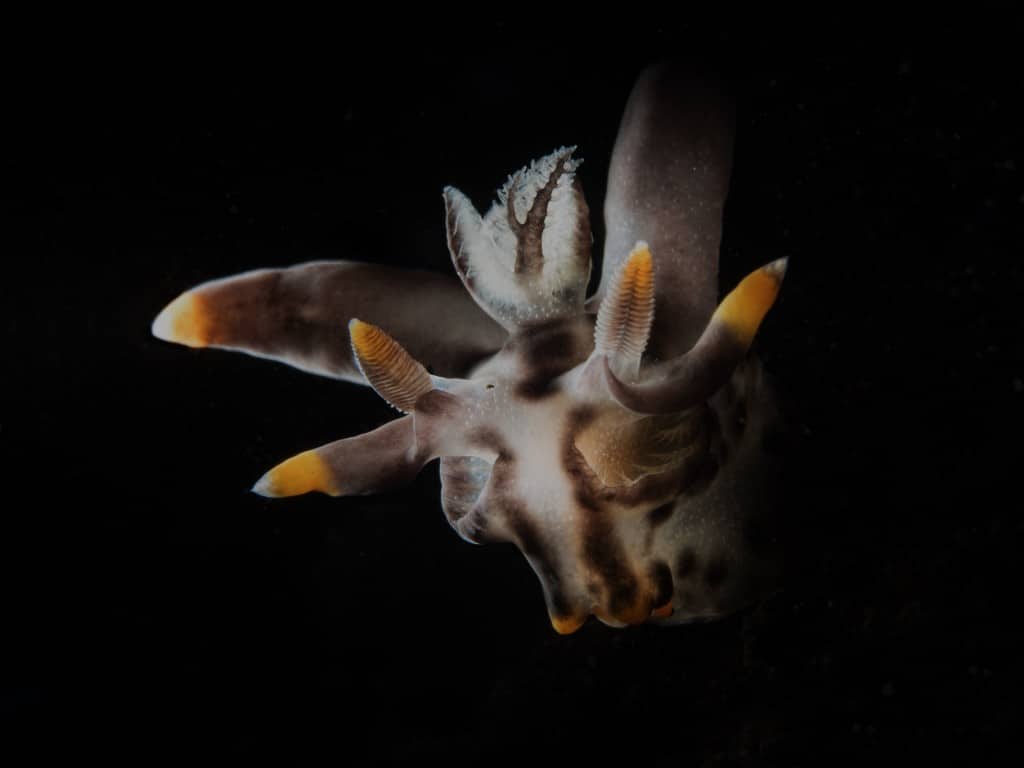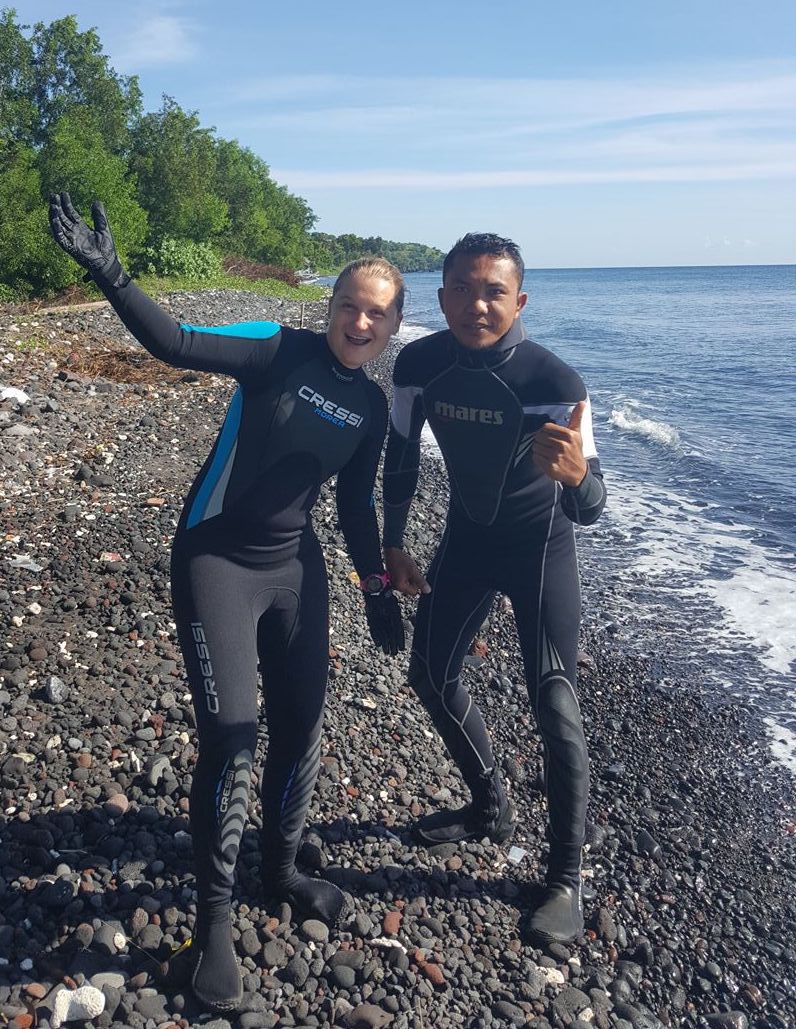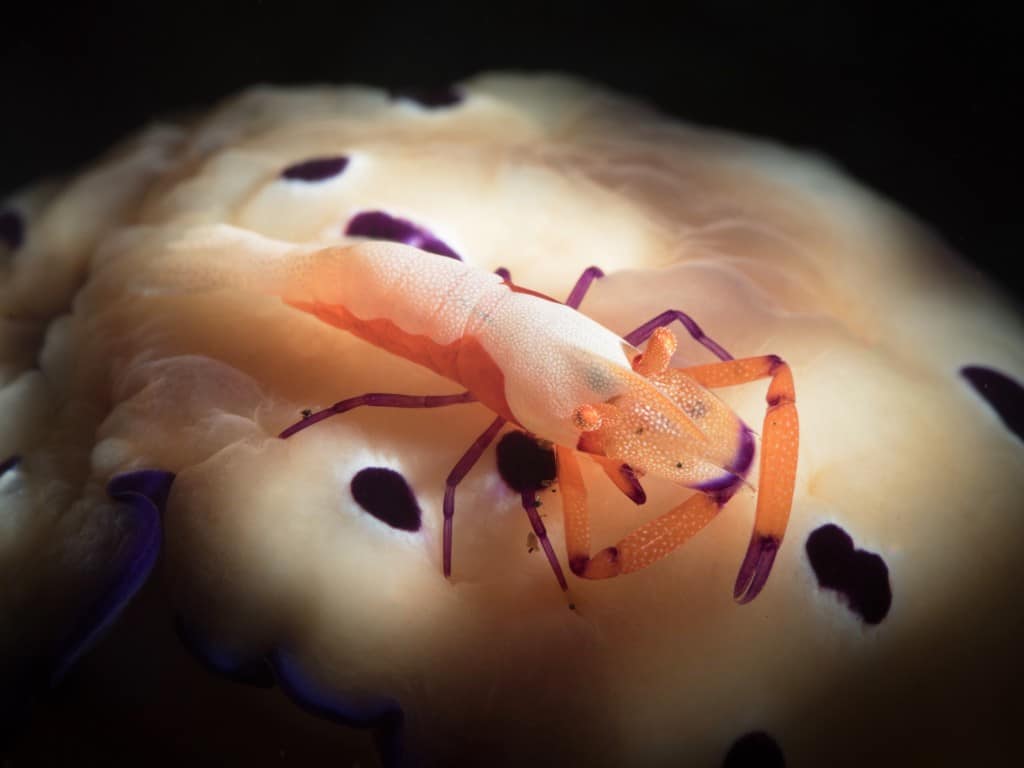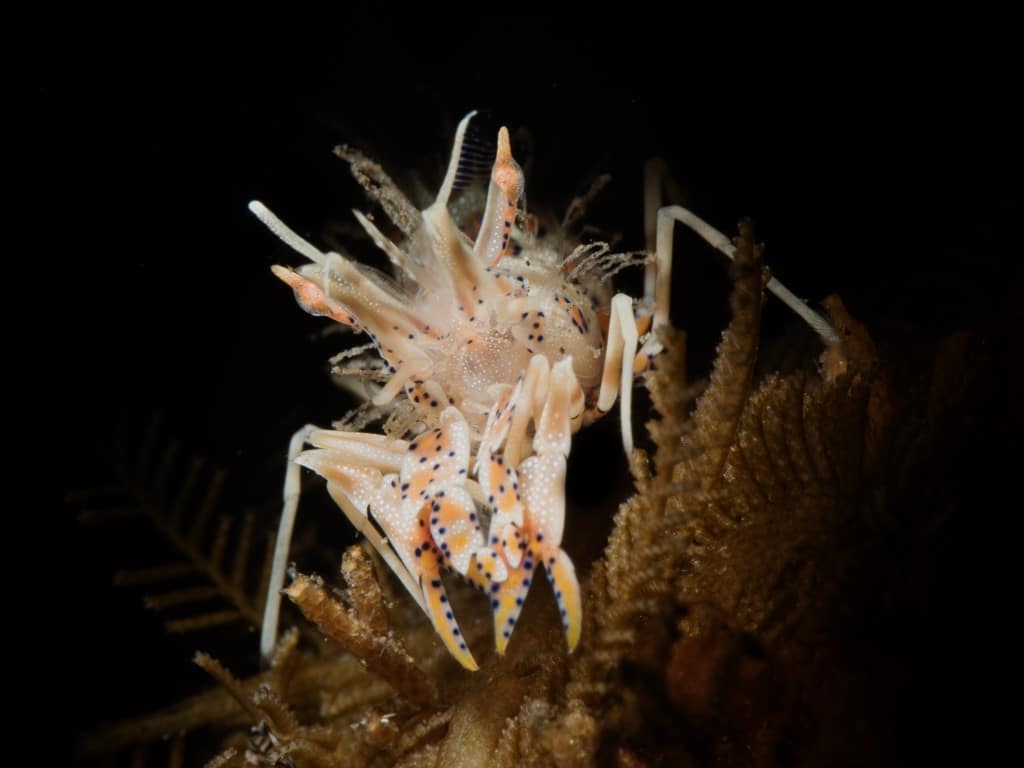News
The Art of Snooting

 Are you a black background enthusiast? Do you enjoy playing with the texture and shadows of your subject? Are you looking for a new challenge? If you answered yes to any of these questions, snooting could be the next technique you need to master!
Are you a black background enthusiast? Do you enjoy playing with the texture and shadows of your subject? Are you looking for a new challenge? If you answered yes to any of these questions, snooting could be the next technique you need to master!
For this post I’ve collaborated with Ajiex Dharma, a freelance dive guide and accomplished macro photographer, based out of Tulamben, Bali. Well known for his signature black background photography, Ajiex regularly teaches keen divers the snooting technique. In this blog, we’re going to be talking through the benefits of snooting and some tips and tricks for you to get started.
Before we get started, what is snooting? Usually reserved for shooting macro subjects, snooting is a lighting technique where a tube or funnel is placed over the front of strobe(s), allowing the photographer to direct light onto the subject in a more precise manner. The photographer will typically shoot photographs of this style using a high shutter speed, higher f-stop value and a low ISO. This creates a crisp black background in contrast to the illuminated subject.

A relatively inexpensive technique to try out for yourself, gear ranges from home made ten dollar funnels, through to the more expensive Retra snoot… and everything in between. There really is an option to suit every budget.
I asked Ajiex what he thinks is the benefit of the technique and what a photographer can expect to gain from shooting using snooted lighting in comparison to a less fiddly technique?
“Snooting is a different shape of lighting. It is particularly useful when you enjoy achieving a black background in your photographs. A snoot is really worth the extra effort for isolating a subject where, due to how the subject is located, you can anticipate a messy foreground or bland background. You can make a subject stunning and elevate your photograph from an ID shot to a work of art!” AD
So, let’s get started, these are our top tips and tricks you need to consider when trying your hand at snooting.
1: Get your buoyancy under control
Snooting requires you to get very close to your subject, so as you can imagine, buoyancy is critically important. As a photographer, you want to approach your subject in a calm and controlled manner to prevent your subject from running away or hiding. Creeping up on your subject with minimal disruption to it or the muck and sand around you will save you time editing out backscatter in post. It will also allow you more time with your subject, minimizing any stress you may cause it.
Additionally, like in all underwater photography, the more rapidly you breathe and the more you move, the faster you’re going to run through your air while also introducing motion blur into your image.
2: Know your camera
“Understanding your equipment is really important. It helps you understand what settings you need to get the shot you want. For example, if you shoot a hairy shrimp with a backlight, you need to know how to capture the details. If you use a big f stop (f5), you will get more light but you will probably find your picture is too bright. You will also find this depth of field too shallow. If you use f22 (or higher) this image will be even better because it will be sharp” AD

As with all macro photography, you need to understand the relationship between ISO, Aperture and Shutter Speed. You will still need to evaluate the size of your subject and the effect you want to create. The lighting technique is not a substitute for good macro practices. Make sure the eyes or key features of your subject are sharp and in focus and that you’re shooting with intent.
3: Get a friend to help you
Picture an actor standing on a stage with a spotlight above them. One step in either direction and your actor is in darkness. A snoot performs in much the same way. The beam of light can be so narrow that one centimetre in the wrong direction and your beautiful nudibranch or decorator crab will be in darkness.
Getting a friend or assistant to give you a hand will make getting the hang of snooting initially much easier. Eventually, after a lot of practice, you will get a feel for the new piece of equipment and will develop an understanding of where the snoot needs to be placed in relation to your camera and subject. However, when you’re just starting, doing this on your own will be infuriating. Your friend or buddy will be able to see the subject easily and help you place the light more efficiently onto the subject.
If your strobe has a focus light, use it. It’s so much easier to be able to see a beam of light coming from your strobe before you take the shot. It will give you a much better idea of what features will be illuminated, how the shadows will fall and whether or not your subject will be over or under exposed.
This will be a great help for your buddy initially to get light placement just right. Additionally, when you come to shooting on your own, this will be an invaluable learning aid.
4: Get creative!
“Snooting is about getting creative and using different lighting. Backlighting, side lighting, it’s about drama!” AD
Remember my spotlight analogy from point two? Now forget it! It’s time to get creative. Top down lighting is not your only option. The real benefit of snooting is that you can direct light precisely from any direction imaginable. When you’re first learning, find a single interesting subject and stay with it. Snoot it from the top, the back (particularly if it’s transparent), the sides, underneath and watch how the shadows and the texture of the subject change. Although maybe try and find a subject without eyes that won’t mind being blasted with light over and over again…
As an example, I’ve included an image below of an emperor shrimp on a nudibranch. I’ve seen many of these pics with the shrimp sitting in between the rhinophores lit from the top down. I wanted to do something different. The snoot was placed facing the shrimps face but with the power of my strobe dialled right down.
By doing this, it allowed me to showcase the texture of the nudibranch skin. You can actually see the little feet of the shrimp digging into the surface of the nudibranch. If you keep looking at the images, you can even see the wrinkles and fold of the skin. I thought it was something beautiful and unique, worth capturing.

To show you a different effect, Ajiex and I photographed the Pikachu nudi using a side lighting technique. The snoot was held to the side of the subject, allowing the transparency to become the feature of the photograph. Additionally, by creating highlights and shallows, the folds of the face became far more apparent. I feel like it gave the subject an interesting personality and interest.

As a final tip, when snooting, remember you don’t have to capture the subject in isolation. Sometimes it is interesting to include a little of the background of context. If there is a beautiful tunicate, try and include this in your shot. Really this tip is about playing with your gear and really finding out what you like and the best way to achieve shots that you feel proud of.
Wrapping up, I really hope you’ve got a good sense of what snooting is and some practical tips to help you get stuck in. It’s a technique I absolutely love using. Despite the initial frustrations of learning how to place the snoot and using the power setting on my strobe to get a light balance that I enjoy, it’s been a really worthwhile challenge and I highly recommend that you give it a go!

If you’re ever in the Tulamben area and want to take lessons or learn more about snooting, you can reach Ajiex here on Facebook or Instagram @ajiexdharma.
Check out more of Miranda-Clare’s photos on Instagram @divingphotos or visit her website www.mirandaclare.com.
Blogs
Discover Curaçao with the Ultimate Dive Vacation Guide – 2024 DEMA Special Edition

Dive Travel Curaçao is thrilled to announce the launch of the Curaçao Dive Vacation Guide – 2024 DEMA Special Edition, an expertly curated resource that unveils the unparalleled dive experiences and vacation possibilities awaiting you in Curaçao. Produced exclusively for the Diving Equipment & Marketing Association (DEMA) Show 2024, this special edition guide is packed with exclusive insights, travel tips, and limited-time DEMA offers that make it easier than ever to explore Curaçao’s stunning underwater landscapes and vibrant culture.
Explore Curaçao’s Unmatched Diving Opportunities
With over 70 diverse dive sites along its southern coastline, Curaçao is a bucket-list destination for divers of all experience levels. From thriving coral reefs and intricate marine ecosystems to historic shipwrecks, the island offers a variety of underwater experiences that are hard to match. The Curaçao Dive Vacation Guide – 2024 DEMA Special Edition provides detailed recommendations for both shore and boat diving, making it a valuable tool for divers seeking the best entry points, pristine reefs, and hidden treasures along the coastline. Whether you are an avid wreck diver, or a beginner interested in shallow reefs, Curaçao has it all.

Uncover Eco-Friendly Dive Resorts and Top Dive Operators
This DEMA 2024-exclusive Curaçao guide goes beyond diving to feature insider information on Curaçao’s eco-friendly accommodations, dive resorts, and top-rated dive operators committed to sustainable dive tourism. From all-inclusive resorts that support coral reef restoration initiatives to charming boutique hotels near prime dive locations, the guide helps travelers find the ideal stay to match their vacation goals. It also spotlights trusted dive operators on the island who prioritize environmental preservation, offering travelers a way to enjoy the underwater world responsibly.

Immerse Yourself in Curaçao’s Culture, Culinary Delights, and Adventure
Curaçao offers a vibrant Caribbean culture rich in history, music, and culinary fusion. The guide reveals Curaçao’s hidden gems, including culinary hotspots, historical sites, and eco-tourism opportunities that will appeal to both divers and non-divers. Visitors can explore the island’s iconic architecture, savor a diverse range of dishes influenced by Caribbean, European, and South American flavors, and embark on land-based eco-adventures, such as hiking, cave exploration, and visiting national parks.

Exclusive DEMA 2024 Specials and Limited-Time Dive Packages
This special edition guide features limited-time DEMA 2024 offers on dive packages, accommodations, and excursions. Travelers who book through Dive Travel Curaçao, or our Curaçao dive travel partners attending DEMA, will have access to exclusive discounts on custom dive vacation packages, making it easier to plan an affordable, high-quality dive trip that fits your preferences. The Curaçao Dive Vacation Guide – 2024 DEMA Special Edition is designed to simplify your travel planning and help you dive deeper into the incredible experiences that Curaçao has to offer.
It’s Time to Dive Curaçao!
Now is the time to discover why Curaçao is a top dive destination in the Caribbean! Dive Travel Curaçao invites you to experience an unforgettable dive vacation with exclusive DEMA 2024 specials tailored just for you. To secure your spot, download a copy of the Curaçao Dive Vacation Guide – 2024 DEMA Special Edition and contact the Dive Travel Curaçao team to start customizing your Caribbean dive adventure today.
For more information and bookings, please visit Dive Curaçao’s website or contact our reservations team directly.

News
Santa Divers take the Plunge for Charity

Ho Ho Ho! Vobster Quay’s recording-breaking charity Santa diving event returns on Sunday 15th December 2024 for another round of festive fundraising frivolities. Run in aid of the Royal National Lifeboat Institution (RNLI) and Help For Heroes, this ever-popular annual fundraising event aims to raise sack-loads of cash for these two very deserving charities.
Divers of all levels are invited to grab their Santa outfits – and as much festive cheer as they can muster – and head down to Vobster Quay near Mells, Somerset for a mass sponsored Santa dive in aid of charity. In previous years, the event has attracted divers from the far corners of the UK to join in the festive merriment for a final festive dive before the Christmas and New Year break. Back in 2015, the event smashed the world record for the most Santa divers with 188 divers taking to the waters donning their festive finery – a record that remains unbeaten to this day!

Vobster Santas isn’t just about setting records – it’s also about raising some serious cash for charity. Vobster Quay encourages all divers to get into the spirit of the season to raise much-needed funds for two very deserving charities – the Royal National Lifeboat Institution (RNLI) and Help For Heroes.
Through individual sponsorship and online donations, divers can invite their friends, family and work colleagues to sponsor them to plunge into the balmy waters of Vobster Quay dressed in full festive finery. Since the very first Santa dive in 2007, the event has raised over £52,000 for charity. “It’s been over 17 years since the very first charity Santa dive took place at Vobster Quay and every year the event just keeps getting bigger and better” enthused Vobster Quay owner, Amy Stanton.
“Vobster Santas is a great way for divers to say a massive thank you to the both the RNLI and Help For Heroes – two very deserving charities close to our hearts. We’re immensely proud of all that Vobster Santas has achieved and hope that even more divers will join this year’s event on Sunday 15th December. I’m confident that we can make Vobster Santas 2024 the biggest yet!”.
Divers wishing to participate can get involved by simply registering their attendance at
www.vobster.com/event-vobstersantas.php.

-

 News1 month ago
News1 month agoIconic SS United States to become the World’s Largest Artificial Reef
-

 Blogs3 months ago
Blogs3 months agoNovoScuba’s Game-Changing Approach for Dive Store Owners: WE PAY YOU!
-

 News2 months ago
News2 months agoBook Review – 52 Assignments: Underwater Photography
-

 Gear News2 months ago
Gear News2 months agoDYNAMICNORD – New German diving brand enters the British market
-

 News2 months ago
News2 months agoExploring Cenote El Pit: A Diver’s Dream
-

 Gear News2 months ago
Gear News2 months agoTry BARE drysuits (and maybe even win one!) this Friday with Sea & Sea at North West Dive Fest
-

 News3 months ago
News3 months agoComing Soon – 52 Assignments
-

 News3 months ago
News3 months agoSave £200 per person per week at Pole Pole Lodge with Dive Worldwide













